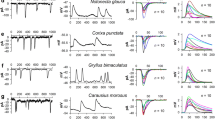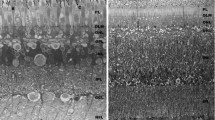Summary
-
1.
Intracellular and extracellular (ERG) recordings were made of receptor responses in the posterior median eye of the nocturnal spiderDinopis subrufus. These are among the largest single lens eyes described among the arthropods and are used during prey capture at night.
-
2.
The receptor potential is a depolarising wave, typical of the responses recorded from other spiders, and from rhabdomeric photoreceptors in general. By comparison with other spiders, the receptor responses are slow in time course. Large (4–12 mV) discrete potentials are seen at very low intensities. The evidence suggests that bumps are responses to single photons. If this is the case the quantum capture efficiency for receptors shown to be in their diurnal state of photoreceptive membrane depletion is 7%, measured relative to photons incident on the cornea.
-
3.
Large responses to single photons and the known light gathering capacity of the lens (Blest and Land, 1977) make individual dark adapted photoreceptors very sensitive. A corneal flux of 5×105 photons·cm−2·s−1 produces an initial responses of half maximal amplitude. This corresponds to an intensity midway between starlight and moonlight under clear sky conditions. 2×105 more light is required to produce the same response in the diurnal jumping spiderPlexippus (Hardie and Duelli, 1978).
-
4.
The spectral sensitivities of single photoreceptors are almost identical to that of the massed receptor response (ERG), and this indicates a retina dominated by photoreceptors containing a single 517 nm rhodopsin. UV sensitivity is depressed by selective attenuation in the lens matrix.
-
5.
The mean receptor angular sensitivity function has a half-width of 2.3°, larger than expected from the optical data, but still sufficient for the resolution of spatial detail whose fineness matches the receptor mosaic.
-
6.
ERG recordings fail to detect the sensitivity shifts that should be associated with the daily cycle of photoreceptive membrane (Blest, 1978). Perhaps such shifts may still exist because we find that our test lights block the synthetic phase of photoreceptive membrane turnover.
-
7.
By comparison with vertebrate rods and cones,Dinopis photoreceptors exhibit the following properties of a scotopic system: large discrete responses to single photons, a slow time course of response, the possibility of electrical coupling between receptors and a spectral sensitivity in the blue/green. The resolving power ofDinopis retina is inferior to human rod vision at the same intensities, as expected of a smaller eye.
Similar content being viewed by others
Abbreviations
- p.m.eye :
-
posterior median eye
- p.l.eye :
-
posterior lateral eye
- PAQ 50 :
-
number of peak axial photons required to produce a half maximal response
- ERG :
-
extracellularly recorded electroretinogram
References
Austin, A.D., Blest, A.D.: The biology of two Australian species of dinopid spider. J. Zool. (London)189, 145–156 (1979)
Autrum, H.: Die Belichtungpotentiale und das Sehen der Insekten (Untersuchungen anCalliphora undDixippus). Z. Vergl. Physiol.32, 176–227 (1950)
Barlow, R.B., Kaplan, E.: Properties of visual cells in the lateral eye ofLimulus in situ. Intracellular recordings. J. Gen. Physiol.69, 203–220 (1977)
Baylor, D.A., Hodgkin, A.L.: Changes in time scale and sensitivity in turtle photoreceptors. J. Physiol. (London)242. 729–758 (1974)
Baylor, D.A., Lamb, T.D., Yau, K.-W.: Responses of retinal rods to single photons. J. Physiol. (London)288, 613–634 (1979)
Blest, A.D.: The rapid synthesis and destruction of photoreceptor membrane by a dinopid spider: a daily cycle. Proc. R. Soc. (London), Ser. B200, 463–483 (1978)
Blest, A.D., Day, W.A.: The rhabdomere organisation of some nocturnal pisaurid spiders in light and darkness. Phil. Trans. R. Soc. (London), Ser. B283, 1–23 (1978)
Blest, A.D., Land, M.F.: The physiological optics ofDinopis subrufus L. Koch: a fish-lens in a spider. Proc. R. Soc. (London), Ser. B196, 197–222 (1977)
Blest, A.D., Williams, D.S., Kao, L.: The posterior median eyes of the dinopid spiderMenneus. Cell Tissue Res.211, 391–403 (1980)
Burkhardt, D., Streck, P.: Das Sehfeld einzelner Sehzellen: eine Richtigstellung. Z. Vergl. Physiol.51, 151–152 (1965)
Carricaburu, P.: Dioptrique oculaire du scorpionAndroctonus australis. Vision Res.8, 1067–1072 (1968)
DeVoe, R.D.: Dual sensitivities of cells in wolf-spider eyes at ultraviolet and visible wavelengths of light. J. Gen. Physiol.59, 247–269 (1972)
DeVoe, R.D.: Ultraviolet and green receptors in principal eyes of jumping spiders. J. Gen. Physiol.66, 193–207 (1975)
DeVoe, R.D., Small, R.J.W., Zvargulis, J.E.: Spectral sensitivities of wolf-spider eyes. J. Gen. Physiol.54, 1–32 (1969)
Dixon, E.R.: Spectral distribution of Australian daylight. J. Opt. Soc. Am.68, 437–449 (1978)
Dodge, F.A., Knight, B.W., Toyoda, J.: Voltage noise inLimulus cells. Science160, 88–90 (1968)
Fain, G.L.: Quantum sensitivity of rods in the toad retina. Science187, 838–841 (1975)
Fleissner, G.: The absolute sensitivity of the median and lateral eyes of the scorpion,Androctonus australis L. J. Comp. Physiol.118, 109–120 (1977)
Fuortes, M.G.F., Hodgkin, A.L.: Changes in the time scale and sensitivity in the ommatidia ofLimulus. J. Physiol. (London)172, 239–263 (1964)
Fuortes, M.G.F., O'Bryan, P.M.: Generator potentials in vertebrate photoreceptors. In: Handbook of sensory physiology, Vol. VII/2, Fuortes, M.G.F. (ed.), pp. 279–320. Berlin, Heidelberg, New York: Springer 1972
Gribakin, F.G., Govardovskii, V.I.: The role of the photoreceptor membrane in photoreceptor optics. In: Receptor optics. Snyder, A.W., Menzel, R. (eds.), pp. 215–236. Berlin, Heidelberg, New York: Springer 1975
Hardie, R.C., Duelli, P.: Properties of single cells in posterior lateral eyes of jumping spiders. Z. Naturforsch.33 c, 156–158 (1978)
Horridge, G.A.: The separation of visual axes in apposition compound eyes. Proc. R. Soc. (London), Ser. B285, 1–59 (1978)
Horridge, G.A., Giddings, C., Stange, G.: The superposition eye of the skipper butterfly. Proc. R. Soc. (London), Ser. B182, 457–495 (1972)
Horridge, G.A., Mimura, K., Hardie, R.C.: Fly photoreceptors III. Angular sensitivity as a function of wavelength and the limits of resolution. Proc. R. Soc. (London), Ser. B194, 151–177 (1976)
Itaya, S.K.: Rhabdom changes in the shrimp,Palaemonetes. Cell Tissue Res.166, 265–273 (1976)
Kirschfeld, K.: The absolute sensitivity of lens and compound eyes. Z. Naturforsch.29c, 592–596 (1974)
Kirschfeld, K.: The resolution of lens and compound eyes. In: Neural principles in vision. Zettler, F., Weiler, R. (eds.), pp. 354–372. Berlin, Heidelberg, New York: Springer 1976
Kunze, P.: Apposition and superposition eyes. In: Handbook of sensory physiology, Vol. VII/6A. Autrum, H. (ed.), pp. 441–502. Berlin, Heidelberg, New York: Springer 1979
Land, M.F.: Structure of the retina of the principle eyes of jumping spiders (Salticidae, Dendryphantinae) in relation to visual optics. J. Exp. Biol.51, 443–470 (1969)
Laughlin, S.B.: The sensitivities of dragonfly photoreceptors and the voltage gain of transduction. J. Comp. Physiol.111, 221–247 (1976)
Laughlin, S.B.: Neural principles in the peripheral visual systems of invertebrates. In: Handbook of sensory physiology, Vol. VII/6B. Autrum, H. (ed.), pp. 133–280. Berlin, Heidelberg, New York: Springer 1980
Lillywhite, P.G.: Single photon signals and transduction in an insect eye. J. Comp. Physiol.122, 189–200 (1977)
Lillywhite, P.G.: Coupling between locust photoreceptors revealed by a study of quantum bumps. J. Comp. Physiol.125, 13–27 (1978)
Machan, L.: Spectral sensitivity of the scorpion eyes and the possible role of shielding pigment effect. J. Exp. Biol.49, 95–105 (1968)
Melamed, J., Trujillo-Cenóz, O.: The fine structure of the visual system ofLycosa (Araneae: Lycosidae). I. Retina and optic nerve. Z. Zellforsch.74, 12–31 (1966)
Munz, F.W., McFarland, W.N.: Evolutionary adaptations of fishes to the photic environment. In: Handbook of sensory physiology, Vol. VII/5. Crescitelli, F. (ed.), pp. 193–274. Berlin, Heidelberg, New York: Springer 1977
Nässei, D.R., Waterman, T.H.: Massive, diurnally modulated photoreceptor membrane turnover in crab dark and light adaptation. J. Comp. Physiol.,131, 205–216 (1979)
Owen, D.B.: Handbook of statistical tables. New York: Addison-Wesley 1962
Pirenne, M.H.: Chapts.1, 9 and 11. In: The eye, Vol. 2. Davson, H. (ed.). New York, London: Academic Press 1962
Robinson, M.H., Robinson, B.: The predatory behaviour of the ogre-faced spiderDinopis longipes F. (Araneae: Dinopidae). Am. Midi. Nat.85, 85–96 (1971)
Rose, A.: Vision, Human and Electronic. New York, London: Plenum Press 1972
Rossel, S.: Regional differences in photoreceptor performance in the eye of the praying mantis. J. Comp. Physiol.131, 95–112 (1979)
Schliwa, M., Fleissner, G.: Arhabdomeric cells of the median eye retinae of scorpions. I. Fine structural analysis. J. Comp. Physiol.130, 265–270 (1979)
Schliwa, M., Fleissner, G.: The lateral eyes of the scorpion,Androctonus australis. Cell Tissue Res.206, 95–114 (1980)
Shaw, S.R.: Polarised light reception and receptor interaction in arthropod compound eyes. Ph. D. Thesis, University of St. Andrews (1968)
Snyder, A.W.: Acuity of compound eyes: Physical limitations and design. J. Comp. Physiol.116, 161–182 (1977)
Snyder, A.W., Stavenga, D.G., Laughlin, S.B.: Spatial information capacity of compound eyes. J. Comp. Physiol.116, 183–207 (1977)
Srinivasan, M.V., Bernard, G.D.: The effect of motion on visual acuity in the compound eye: a theoretical analysis. Vision Res.15, 515–525 (1975)
Stowe, S.: Rapid synthesis of photoreceptor membrane and assembly of new microvilli in a crab at dusk. Cell Tissue Res.211, 419–440 (1980)
Whittle, A.C.: Reticular specialisations in photoreceptors: a review. Zool. Scripta5, 191–206 (1976)
Yamashita, S., Tateda, H.: Spectral sensitivities of jumping spider eyes. J. Comp. Physiol.105, 29–41 (1976)
Yeandle, S.: Evidence of quantized slow potentials in the eye ofLimulus. Am. J. Ophthalmol.46, 82–87 (1958)
Author information
Authors and Affiliations
Rights and permissions
About this article
Cite this article
Laughlin, S., Blest, A.D. & Stowe, S. The sensitivity of receptors in the posterior median eye of the nocturnal spider,Dinopis . J. Comp. Physiol. 141, 53–65 (1980). https://doi.org/10.1007/BF00611878
Accepted:
Issue Date:
DOI: https://doi.org/10.1007/BF00611878




